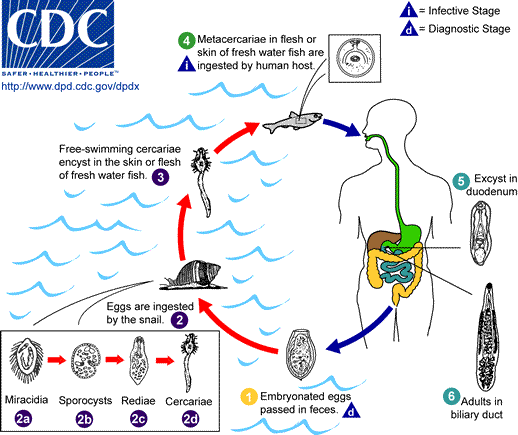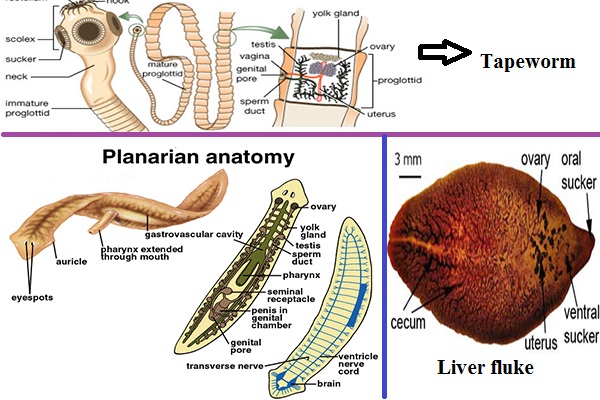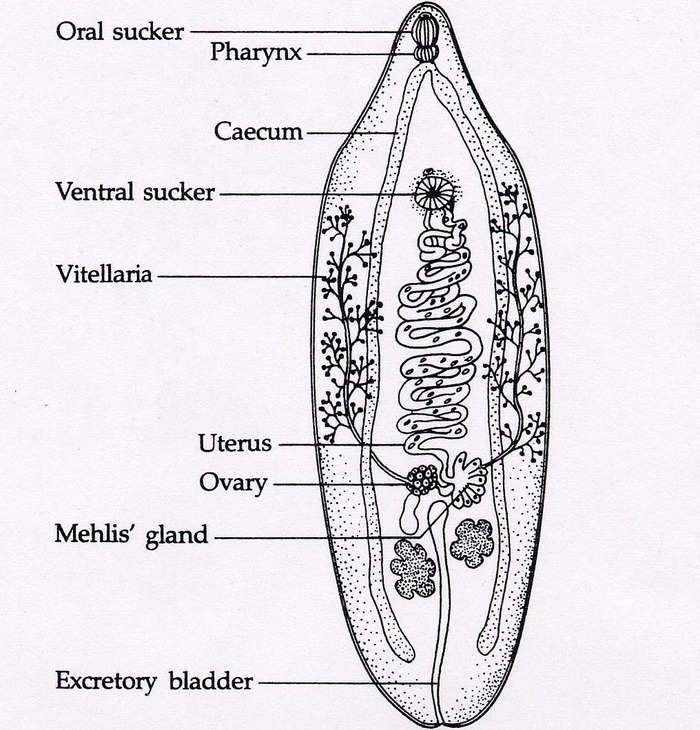Information about Platyhelminthes
Information about Platyhelminthes
Platyhelminthes (Gr. Platy- flat; helminthes- worm)
Platyhelminthes is commonly known as flatworm or tapeworm.
Gegenberg gave the term Platyhelminthes.
They are advanced diploblastic or lower triploblastic, acoelomate and bilaterally symmetrical metazoan.
General characters
- Body is elongated, dorsoventrally flattened, soft leaf like or tape like.
- Body is covered by ciliated epithelium or cuticle.
- Mostly parasitic (ecto- or endo-), some are free-living.
- Parasitic form have adhesive structures like spines, hooks, suckers and other devices for attachment with host.
- Soft bodied. May be segmented or non-segmented.
- Body wall is triploblastic i.e. made up of 3 layers; outer ectoderm, middle mesoderm and inner endoderm.
- Bilaterally symmetrical with definite polarity of anterior (head) and posterior (tail) end.
- They are acoelomate animals. Space between body wall and internal organs is filled up with parenchyma.
- Organ system of body level of organization.
- Nutrition is holozoic type.
- Digestive system is incomplete without anus or absent in few parasitic form.
- Respiratory and circulatory organ are absent.
Respiration occurs through general body surface. Anaerobic respiration occurs in parasites and aerobic in free-living. - Excretory organs are flame cells or protonephridia or solenocytes.
- Nervous system is primitive and ladder like.
It consists of a pair of anterior ganglia with longitudinal nerve cords connected by transverse nerves. - Sense organ are usually absent or reduced in parasitic forms.
But sense cells are found in the body wall of turbellarians and are able to respond various stimuli. - They are hermaphrodite or bisexual or monoecious except Schistosoma.
- Reproductive system is well developed.
Reproduction occurs sexually but in few forms such as freshwater form asexual reproduction occurs by fission. - Fertilization is internal and may be cross or self.
- Development may be direct or indirect. Usually indirect in endo-parasites with complicated life cycle involving many larval stages and hosts. Direct in free living forms.
- Majority of them are colorless, some derive color from the ingested food, while some are free living forms are brown grey black or brilliantly colored.
- They have a clearly differentiated head situated anteriorly and delicate posterior end. They are clearly defined dorsal and ventral surfaces.
- Locomotory organ are absent.
- The exoskeleton and endoskeleton are absent and hard parts if any such as hooks, teeth etc. are formed of scleroproteins.
Classification of Phylum Platyhelminthes
On the basis of habitat and segmentation / digestive tract and habitat/ Hook and sucker, they are classified into 3 types:
- Turbellaria
- Trematoda
- Cestoda
| Characters | Turbellaria | Tematoda | Cestoda |
| Commonly called | Eddyworm. |
Flukes
|
Tapeworm.
|
| Mode of life | Free living aquatic forms.
|
Exclusively parasites (ecto and endo).
|
Endoparasites
|
| Segmentation | Body is unsegmented. | Unsegmented.
|
Segmented
|
| Epidermis and cilia | Epidermis cellular, covered by cilia. | Cilia and epidermis absent.
|
Cilia and epidermis absent.
|
| Hooks and sucker | Absent. | Suckers present, hooks absent.
|
Hooks and suckers are present.
|
| Digestive system | Digestive system consists: mouth pharynx and intestine. Alimentary canal without anus. | Alimentary canal without anus.
|
No alimentary canal. No mouth.
|
| Life cycle | Life cycle is simple.
|
Life cycle is complex require one or more hosts.
|
Complex, may require one or more hosts.
|
| Head | Distinct head is present at the anterior end of the body.
|
Head is present.
|
Very small head or scolex which is provided with sucker and hooks for attachment to host. |
| Examples | Dugesia | Fasciola hepatica
|
Taenia solium, Taenia saginata
|
Things to Remember
- Flatworms are first animals to have-
Organ grade of body organization.
Cephalization triploblastic and bilaterally symmetry. - Blind sac body plan.
The complete absence of alimentary canal is seen in animal like tapeworm where food is absorbed through general body surface. - Flame cells arise from mesoderm and are unicellular uni-nucleate and ovoid.
Main excretory products are ammonia, fatty acids and CO2. - Sensory organ are well defined in free living forms than in parasitic forms.
Sense organ like eyes (which are not image forming but can detect changes in intensity of light), auricle, papillae etc. are present in free-living forms like planaria.
Fasciola hepatica
- Liver fluke is a leaf like which is found in liver and bile ducts of sheep and goat as endo-parasite. Also found in cattle, dog and pig and rarely in man.
- Liver may cease to work due to the presence of adult flukes. This condition is known as liver rot.
Triclabendazole is used to treat liver rot. - Body is soft oval with pink as ground color and brown boarder due to the presence of vitelline glands and intestinal caeca.
- The head bears mouth which is surrounded by anterior sucker.
- Other sucker is also present which is called ventral sucker or acetabulum.
- During breeding seasons, a temporary opening called Laurer’s canal is seen on dorsal surface.
- Digestion is extracellular and takes place mainly in intestine.
Absorption of food takes place through intestinal caeca by the help of mesenchyme from where distribution of simple food takes place throughout. - Hermaphrodite i.e. both male and female gonads are present in same individual.
- Located between the two suckers is a single mid-ventral genital pore or gonopore.
- Male reproductive system consists of two testes, one pair of vas deferens (sperm ducts), a seminal vesicle and a muscular penis called cirrus.
- Female reproductive system consists of an ovary, an ovidut, vitelline glands, Mehli’s or shell glands, vitelline ducts, Vitelline or yolk reservoir, ootype uterus, metaterm and female genital pore situated in the right half of the body.
- Ootype is surrounded by Mehil’s gland or shell gland; secretion of which lubricates the passage and hardens the egg.
- Life cycle is digenetic- sheep or goat as its primary host and snail as secondary host.
- Fasciola is harmless to snail but is pathogenic in vertebrate hosts including man.
 Larval stage completes in five stages. Different larval stages are:
Larval stage completes in five stages. Different larval stages are:
Miracidium Sporocysts Redia Cercaria Metacercaria
Information about Platyhelminthes
(Visited 19,723 times)


